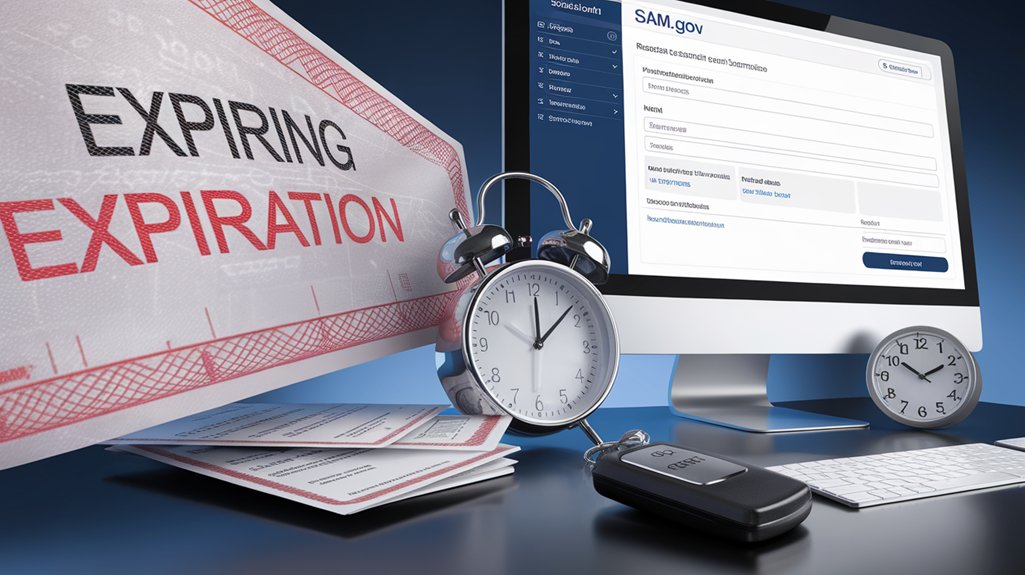CAGE codes issued after August 26, 2016 expire after five years, while SAM registrations require annual renewal regardless of CAGE code status. Contractors must verify core data, update business information, and submit compliance documentation during renewal. Best practices include conducting biannual audits, monitoring SAM.gov notifications, and initiating renewals 60 days before expiration. Proactive maintenance prevents contract award delays and payment interruptions. The following guide provides essential strategies for maintaining continuous federal contracting eligibility.
Understanding CAGE Code Expiration Rules

While charting federal contracting requirements, businesses must understand that Commercial and Government Entity (CAGE) codes follow specific expiration timelines based on when they were issued. The CAGE code significance in federal contracting cannot be overstated, as these identifiers are mandatory for all vendors doing business with the government.
Codes issued after August 26, 2016, operate on a five-year expiration cycle, while those assigned before this date remain valid indefinitely unless entity information changes. The expiration impact directly affects an organization’s ability to receive contract awards and payments. Each time a company updates its System for Award Management (SAM) registration, the five-year countdown resets.
For U.S. entities, CAGE expiration dates appear on the SAM.gov dashboard, but foreign entities with NCAGE codes currently operate without expiration dates. Maintaining registration in SAM system is essential for continued access to federal funding opportunities. A comprehensive guide for obtaining a CAGE code can help businesses navigate the initial application process smoothly. DLA will implement a phased approach for adding expiration dates to all CAGE codes, marking the first change to the system in 44 years.
When codes expire, they trigger an automatic review process by the Defense Logistics Agency rather than requiring formal renewal.
Step-by-Step SAM Registration Renewal Process

Because CAGE codes are directly tied to SAM registrations, contractors must follow a structured renewal process to maintain their active status in the federal procurement system. The renewal timeline requires action every 365 days to prevent expiration and potential loss of contracting opportunities.
Prompt CAGE code renewal is essential—let your SAM registration lapse and risk exclusion from federal contracts.
The process begins with preparation, gathering essential documents including the UEI, TIN, and banking information. Once prepared, contractors must log into SAM.gov through Login.gov credentials and navigate to “Register/Update Entity” to locate their existing registration.
During renewal, contractors must validate core data, update any changed business information, and complete all representations and certifications. Registration requirements include verifying NAICS codes, ownership details, and financial information remain current. Maintaining active SAM registration ensures continuous eligibility for federal contracts and prevents disruptions in business opportunities. Proactive renewal strategies are recommended at least 60 days before expiration to allow sufficient time for processing and avoid any potential service disruptions.
After addressing all compliance documentation, contractors should conduct a final validation before submission and monitor their application status, which typically processes within 2-10 business days. Remember that seeking assistance from APEX Accelerators can provide valuable support for small businesses navigating the renewal process.
Best Practices for CAGE Code Maintenance

Maintaining an active CAGE code requires vigilant management and adherence to federal compliance standards. Organizations should implement structured CAGE compliance strategies, including six-month scheduled audits to prevent data discrepancies between SAM.gov profiles and CAGE master files.
Companies should leverage SAM.gov’s notification system to receive automated registration expiration alerts. The 30-day notification rule for CAGE code changes must be strictly followed, ensuring contracting officers receive timely updates for contract modifications. The five-character alphanumeric identifier must be accurately maintained in all business documentation to facilitate proper tracking by government agencies. Understanding the registration process is essential for organizations navigating the complexities of federal contracting requirements.
For multinational entities, implementing dual-code systems using both CAGE and NCAGE codes streamlines NATO contract processing. Entities engaged with NATO should reference the available instructional video on obtaining NCAGE Codes.
Documentation management is critical – organizations should maintain thorough change logs that align with SAM.gov archives. Implementing API integrations between enterprise systems and SAM.gov creates automated CAGE renewal workflows, reducing the risk of unexpected expirations.
For small and medium enterprises, establishing training partnerships with Procurement Technical Assistance Centers provides valuable compliance support for registration notification protocols.
Frequently Asked Questions
Can CAGE Codes Be Transferred Between Business Entities?
CAGE codes cannot be transferred between business entities. Each code is uniquely assigned to a specific legal entity at a distinct physical address.
When businesses merge or ownership changes occur, the smaller entity’s CAGE code typically becomes deactivated. Contracts associated with deactivated codes require formal novation agreements or SF30 modifications to reassign obligations to the surviving entity’s CAGE code.
Companies must notify contracting officers of these changes within 30 days to maintain compliance.
How Are CAGE Codes Affected During Company Mergers or Acquisitions?
During company mergers or acquisitions, CAGE codes face several impacts requiring careful management.
Merger implications typically include notifications to contracting officers and updates in the System for Award Management (SAM).
Acquisition processes may require entities to consolidate or maintain separate CAGE codes based on the resulting business structure.
Companies must submit documentation like Novation Agreements to transfer contract obligations properly.
Timely updates prevent contract execution delays while ensuring regulatory compliance.
The acquiring company must verify all records accurately reflect the new organizational structure.
Can a Business Have Multiple CAGE Codes Simultaneously?
Yes, a business can have multiple CAGE codes simultaneously. Companies often maintain separate codes for different physical locations, divisions, or subsidiaries as part of effective CAGE code management.
This approach offers several CAGE code benefits, including clearer identification of specific business units when contracting with government agencies.
Organizations must guarantee proper registration of each code in SAM.gov and maintain compliance requirements for all assigned codes, particularly when dealing with defense contracts requiring CMMC certification.
What Happens if a CAGE Code Application Is Rejected?
When a CAGE code application is rejected, businesses face immediate consequences. The company becomes ineligible for federal contract awards and existing proposals may be disqualified.
The rejection typically includes specific reasons, such as incomplete information or documentation errors. Businesses must address these issues and complete application resubmission through SAM.gov.
During this period, the company cannot receive federal contracts that require CAGE code verification, potentially causing significant business disruptions and revenue loss.
Are CAGE Codes Public Information or Restricted Access Only?
CAGE code visibility varies based on entity preferences.
While most CAGE codes are publicly accessible through SAM.gov, some organizations restrict access to their information.
Entity-controlled CAGE code privacy settings determine whether the public can view their registration details.
Government users typically have greater access privileges than public users.
For example, the CMMC-AB chose to restrict public visibility of their CAGE code status, while maintaining government access to their information.